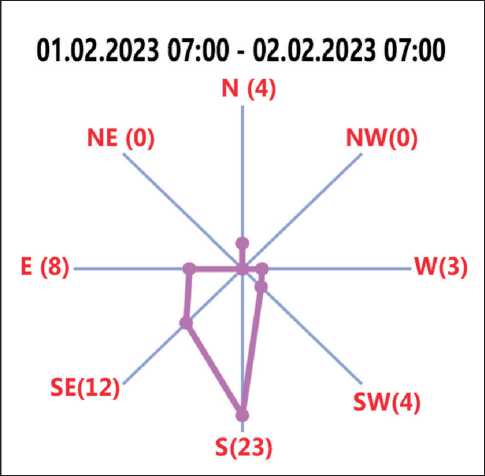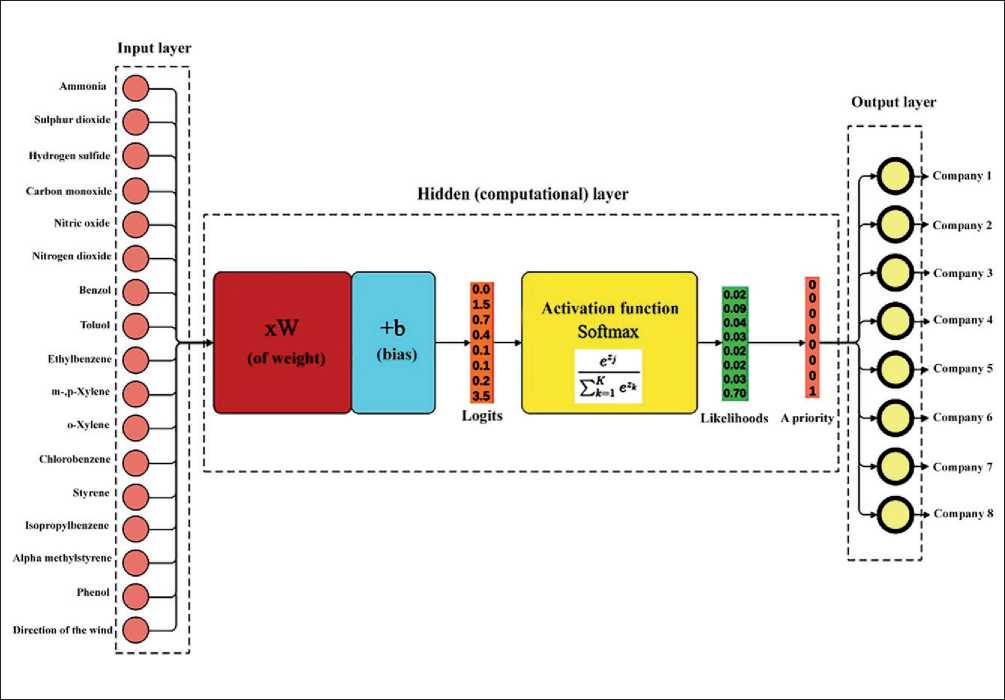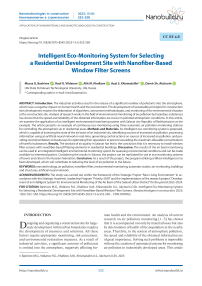Intelligent Eco-Monitoring System for Selecting a Residential Development Site with Nanofiber-Based Window Filter Screens
Автор: Mussa G. Bashirov, Rauf G. Vildanov, Alik M. Khafizov, Azat S. Khismatullin, Damir Sh. Akchurin
Журнал: Nanotechnologies in Construction: A Scientific Internet-Journal @nanobuild-en
Рубрика: Application of nanomaterials and nanotechnologies in construction
Статья в выпуске: 6 Vol.15, 2023 года.
Бесплатный доступ
Introduction. The industrial activities result in the release of a significant number of pollutants into the atmosphere, which have a negative impact on human health and the environment. The development of sustainable principles for construction sites development requires the elaboration of algorithms, assessment methodologies, and monitoring of the environmental situation at the construction site. Analysis of research works in the field of environmental monitoring of air pollution by hazardous substances has shown that the speed and reliability of the obtained information are crucial in polluted atmospheric conditions. In this article, we examine the application of an intelligent environmental monitoring system with Salavat city Republic of Bashkortostan as the example. The article presents an example of continuous eco-monitoring using three automatic air pollution monitoring stations for controlling the atmospheric air in residential areas. Methods and Materials. An intelligent eco-monitoring system is proposed, which is capable of assessing the state of the air basin of an industrial city, identifying sources of increased air pollution, processing information using an artificial neural network in real-time, generating control actions on sources of increased air pollution, and providing recommendations to businesses for optimizing their operations to prevent exceeding the maximum allowable concentrations of harmful substances. Results. The analysis of air quality in Salavat has led to the conclusion that it is necessary to install window filter-screens with nanofiber-based filtering elements in residential buildings. Discussion. The results of the air basin monitoring can be used in an integrated intelligent environmental monitoring system for assessing environmental conditions and can be made available to interested parties. Considering the results in Salavat, the project can be replicated for use in eco-monitoring systems of towns and cities in the Russian Federation. Conclusion. As a result of the project, the program utilizing artificial intelligence has been developed, which will contribute to reducing the level of air pollution in the future.
Nanotechnology, air pollution, nanofiber filter, environmental monitoring, automatic station, air monitoring, buildings and structures, artificial neural network
Короткий адрес: https://sciup.org/142239113
IDR: 142239113 | DOI: 10.15828/2075-8545-2023-15-6-552-558
Текст научной статьи Intelligent Eco-Monitoring System for Selecting a Residential Development Site with Nanofiber-Based Window Filter Screens
Original article
D esigning and organizing a construction site for large-scale development within urban boundaries requires the development of measures and solutions. All these factors require appropriate monitoring, risk assessment, and environmental restoration measures. As a result of industrial activities, a significant amount of pollutants is emitted into the atmosphere, negatively affecting hu-
man health and the environment. An analysis of current research on air pollution monitoring [1–5] has shown that it is accompanied not only by material losses but also by deterioration of health of the population in the nearby areas. Therefore, in the context of atmosphere pollution, the speed and reliability of the obtained information are of great importance. Solving such problems is impossible without the creation of automated systems for monitoring air pollution in industrially developed areas. This article
АPPLICATION OF NANOMATERIALS AND NANOTECHNOLOGIES IN CONSTRUCTION examines the application of an intelligent environmental monitoring system using the example of Salavat city, Republic of Bashkortostan.
The city of Salavat is located on a flat area, stretching from north to south and bordered on the eastern side by the Belaya River. Based on the “wind rose,” the prevailing wind direction is from the southwest. The main part of the city lies at the lowest absolute elevations of 145–155 meters. Rising above at absolute elevations of 165–170 meters is the northern industrial zone, while the southern industrial zone is situated at elevations of 170–220 meters. The positioning of the residential area relative to the industrial zones leads to valley-shaped local effects that contribute to the accrual of pollutants in the air’s surface layer. Considering that there were 225 calm weather days in 2022, such meteorological conditions favor the concentration of harmful emissions in the atmosphere [6–7].
The aim and objective of the work is to create a center for receiving, controlling, automatic processing of information, to develop an artificial neural network for an intelligent system for analyzing the level of air pollution in the city of Salavat.
METHODS AND MATERIALS
According to source [7], in 2022, Salavat’s air pollution levels, in line with SanPin 2.1.6.3492-21 criteria, were raised and were primarily determined by the concentrations of formaldehyde, ammonia, and nitrogen dioxide. The annual average concentrations of the main pollutants such as sulfur dioxide, nitrogen oxide, carbon monoxide, suspended matters, nitrogen dioxide, and benzopyrene remain below permissible standards. An elevated level of emissions is bolstered by an increased proportion of fuel oil in the fuel mix of electric power enterprises.
The Salavat city administration in conjunction with Gazprom Neftekhim Salavat LLC have initiated an online system for monitoring air pollution in the urban air basin, allowing for swift detection of airborne contaminants whose concentration exceeds the maximum permissible concentration (MPC). This system facilitates the documentation and identification of gaseous emissions, data collection, and trend analysis of air pollution over time. Consequently, it assists environmental specialists in evaluating air quality in Salavat.
Currently, three pollution monitoring stations (PMS) operate in Salavat: a mobile bus station PMS-1 in a heavytraffic area, and two stationary automatic stations, PMS-2 and PMS-3, for monitoring pollution levels in residential areas.
These monitoring posts are equipped with modern automatic air pollution stations (AAPS), functioning 24/7 and capable of identifying up to twenty-three different pollutants. Additionally, the AAPS station is equipped
with an ultrasonic weather station for the automated measurement of basic meteorological parameters [8–9].
Exceeding the maximum permissible concentrations of polluting gases can lead to serious consequences for human and animal health, as well as environmental degradation. Taking into account the “wind rose” (a graphical representation of wind directions and speeds in a certain area), it is possible to determine and assess which directions and how quickly these pollutants may be dispersing.
Data on harmful factors are gathered semi-hourly from various pollution monitoring stations (PMS). For a more detailed assessment, the data received from the AAPS stations were examined. Accordingly, the monitoring is carried out continuously, the readings are recorded in Excel files. These spreadsheets not only serve as records but also as potential datasets for training neural networks [10].
A detailed examination of the AAPS’s statistics revealed that the station placements within Salavat are strategically set to capture Maximum Permissible Concentrations (MPC) of pollutants: from the south at PMS No. 3 (Meleuz and Salavatsteklo JSC), centrally at PMS No. 2 (general situation within the city), and from the north at PMS No. 1 (Gazprom Neftekhim Salavat LLC, with processes occurring in Ishimbay and Sterlitamak). This strategic placement aids in surveilling air quality within specific city zones and identifying probable pollution sources.
RESULTS AND DISCUSSION
The solution to the problem is complex. Automated samplers in potential sources of contamination, if necessary, promptly inform special services about the environmental situation in the city of Salavat. These devices are equipped with special sensors and software. The authors have developed an integrated intelligent system for managing this system for monitoring and analysis of data concerning Salavat’s environmental status [10].
The use a neural network in the environmental monitoring system enhances the precision, oversight, dependability of the data gathering process, and the management of environmental conditions. This approach contributes to the minimization of negative environmental factors, as well as reducing the expenses associated with environmental strategies and interventions.
The principal element of the system, presented in Figure 2, is a neural network. This is a machine-learning approach that makes it possible to predict changes in the environmental situation based on existing data and trend analysis.
A neural network-based environmental monitoring system can be seamlessly integrated alongside other monitoring and control systems, such as light and temperature control systems in buildings, transport manage-
АPPLICATION OF NANOMATERIALS AND NANOTECHNOLOGIES IN CONSTRUCTION
Results of automated monitoring of pollutants in the atmospheric air (AASP) according to B.S. Yulaeva, 8b Salavat from 01.02.2023 7:00 to 02.02.2023 7:00
|
Ingredient |
s.s. Concentration of pollutants mg/m3 |
MPC s.s. mg/m3 |
Excess in fractions of MPC s.s. ≥ 1 |
m.r. Concentration of pollutants mg/m3 |
MPC m.r. mg/m3 |
Excess in fractions of MPC m.r. ≥ 1 |
Time max. emission m.r. concentrations of pollutants |
|
Ammonia |
no data |
0.1 |
no data |
0.2 |
|||
|
Sulphur dioxide |
0.0036 |
0.05 |
0.0064 |
0.5 |
01.02.2023 18:20 |
||
|
Hydrogen sulfide |
0.0022 |
– |
0.0049 |
0.008 |
01.02.2023 21:20 |
||
|
Carbon monoxide |
0.6382 |
3.0 |
1.6016 |
5.0 |
01.02.2023 18:40 |
||
|
Particulate matter PM 10 |
no data |
0.06 |
no data |
0.3 |
|||
|
Particulate matter PM 2,5 |
no data |
0.035 |
no data |
0.16 |
|||
|
Particulate matter PM 1 |
no data |
– |
no data |
– |
|||
|
Nitric oxide |
0.0319 |
– |
0.1317 |
0.4 |
01.02.2023 18:40 |
||
|
Nitrogen dioxide |
0.0595 |
0.1 |
0.1104 |
0.2 |
01.02.2023 22:20 |
||
|
Benzol |
0.0091 |
0.06 |
0.0236 |
0.3 |
01.02.2023 20:30 |
||
|
Toluol |
0.0106 |
– |
0.0215 |
0.6 |
01.02.2023 20:00 |
||
|
Ethylbenzene |
0.0005 |
– |
0.0010 |
0.02 |
01.02.2023 20:00 |
||
|
m-, p-Xylol |
0.0022 |
0.04 |
0.0044 |
0.25 |
01.02.2023 20:30 |
||
|
o-Xylol |
0.0026 |
– |
0.0040 |
0.3 |
02.02.2023 6:00 |
||
|
Chlorobenzene (C6H5Cl) |
0.0001 |
– |
0.0001 |
0.1 |
01.02.2023 10:00 |
||
|
Styrol (C8H8) |
0.0000 |
– |
0.04 |
||||
|
Isopropylbenzene (C9H12) |
0.0000 |
– |
0.014 |
||||
|
Alpha methylstyrene (C9H10) |
0.0003 |
– |
0.0009 |
0.04 |
02.02.2023 6:00 |
||
|
Phenol (C6H5OH) |
0.0000 |
0.006 |
0.01 |
||||
|
Acetone (C3H6O) |
0.0788 |
– |
0.3667 |
0.35 |
1.0 |
01.02.2023 20:30 |
|
|
Methanol (CH4O) |
0.0351 |
0.5 |
0.0738 |
1.0 |
01.02.2023 21:30 |
||
|
Ethylene (C2H4) |
0.0006 |
– |
0.0036 |
3.0 |
02.02.2023 4:00 |
||
|
Dimethylamine (CH32NH) |
0.0000 |
0.0025 |
0.005 |
Fig. 1. Example of data gathered by an AAPS station, indicating MPC and taking into account the “Wind Rose”
ment systems, etc. The intelligent environmental monitoring system aggregates real-time data at a centralized hub on pollutant levels from automated sampling and control equipment from AAPS, alongside information on atmospheric air conditions such as temperature, pressure, humidity, and forthcoming weather forecasts. The intelligent environmental monitoring system engages in the processing and surveillance of the data, forecasting of pollutant emissions, activation of preliminary contamination warning mechanisms, and formulation of guidelines regarding the maximum thresholds of safe emissions by optimizing operational loads on appliances. It automatically identifies the pollution sources and causes, amplifies air filtration quality, and regulates the reduction in transportation air pollution. Additionally,

АPPLICATION OF NANOMATERIALS AND NANOTECHNOLOGIES IN CONSTRUCTION

Fig. 2. Structure of an Intelligent Algorithm Based on a Logistic Regression Model
data are sent to municipal environmental monitoring centers and to petrochemical and industrial companies in order to adjust the general regulations on the emission of harmful gases.
An artificial neural network will analyze data from meteorological stations and automated chromatographs, as well as gas-analyzing systems of the online monitoring system for air pollution of Salavat. The intelligent system assesses the current state of pollution in the city’s air basin and predicts pollution progression scenarios, taking into account meteorological station data, weather forecasts, and formulates generates control actions on sources of intense air pollutants. It also provides recommendations for enterprises to optimize operational protocols to prevent exceeding the maximum permissible concentration of harmful substances in the city’s air basin.
The project of software interface design is shown in Figure 3. This interface is composed of input areas from AAPS data values, a display section for outcomes, and a ‘Calculate’ button.
The result of training an intelligent model is its accuracy. The accuracy stands at 59.73%, indicating a correlation between the parameters and the practical significance of the study. The relatively low accuracy is attributed to
|
■ MainWindow |
Meaning |
- □ X Result |
|
— |
Most likelv |
|
|
Ammonia; |
||
|
0,001456671 |
pollutant: |
|
|
Sulphur dioxide; |
0,000498219 |
|
|
Hydrogen sulfide: |
0 |
|Enterprise 1 (pl)| |
|
Carbon monoxide; |
0,0001 |
|
|
Nitric oxide; |
0,001 |
|
|
Nitrogen dioxide; |
0,013344658 |
|
|
Benzol; |
0,001126531 |
|
|
Toluol; |
0,000135714 |
|
|
Ethylbenzene; |
0,0001 |
|
|
m-,p-Xylene; |
0 |
|
|
o-Xylene; |
0,060071429 |
|
|
Chlorobenzene; |
0 |
|
|
Styrene; |
0 |
|
|
Isopropylbenzene; |
0 |
|
|
Alpha methylstyrene; |
0,003787959 |
|
|
Phenol; |
0 |
|
|
Acetone; |
0,020408163 |
|
|
Methanol; |
0,215367347 |
|
|
Temperature; |
21,1 |
|
|
Direction of the wind. |
___________12 |
|
|
Calculate |
Fig 3. Program Interface Project
АPPLICATION OF NANOMATERIALS AND NANOTECHNOLOGIES IN CONSTRUCTION the limited amount of statistical data collected, which is an area for further investigation.
The intelligent environmental monitoring system can be constantly improved by incorporating new devices with enhanced metrological characteristics. Additionally, the system can benefit from the integration of web technologies for comparing and exchanging data with other sources. The findings from monitoring the air basin can be utilized in an integrated intelligent system for monitoring environmental pollution, including soil and water contamination, as well as the impact on flora and fauna. These results can be shared with interested parties to evaluate the environmental situation and contribute to fostering «transparency in environmental matters» [11– 15]. Taking into account the results in the city of Salavat, this project can be replicated for the implementation of environmental monitoring systems in small and mediumsized towns and cities across the Russian Federation.
Following the analysis of air samples, the intelligent environmental monitoring system suggests the installation in residential buildings a window filter-screen with nanofiber-based filtering elements, such as the one offered by Respilon [16].
Table 1
Test Results of a window filter-screen with nanofiberbased filtering elements
|
Filtration Efficiency |
Filter-screen “Respilon” |
|
1.0 µm particles |
82.9 % |
|
2.5 µm particles |
97.6 % |
|
5.0 µm particles |
100 % |
A window filter-screen with nanofiber-based filtering element is a filter made of nanofibers that have a diameter of about a few nanometers, designed to be installed in windows. It forms a barrier against the penetration of dust, pollen, including viruses and bacterial spores. It also helps inhibit the spread of mold while providing high permeability to air, gases, and water vapors. The particles are captured mechanically. Thus, the membrane is suitable for use in homes where individuals suffer from allergies, asthma, cardiovascular disorders, lung diseases, or reside in areas with high levels of air pollution.
The unique filtration ability is provided by a layer of nanofibers.
The membrane of Respilon company consists of three layers:
Layer 1: A breathable mesh frame that provides protection against dust, insects and other particles, while allowing for proper air circulation.
Layer 2: A filtering breathable membrane made of nanofiber, capable of retaining and trapping fine particles of several nanometers in size. This membrane has high air permeability, ensuring good air circulation while effectively capturing contaminants. The use of such filter-permeable nanofiber membranes helps improve indoor air quality and protect individuals from harmful outside emissions.
Layer 3: A breathable protective mesh used to protect against dust, insects, and prevent unwanted elements from entering the room.
An intelligent environmental monitoring system can be used to optimize the production of nanofiber materials to achieve higher filtration efficiency of incoming air. Additionally, by integrating environmental monitoring and controlling the filtration process of atmospheric air entering the room, the system can improve the performance and durability of filters.
In Salavat, the main air pollutants consist of chemical elements ranging in size from 3 to 8 nanometers. Therefore, it is advisable to minimize the inhalation of these “gases”. Installing air handling units (breathers) at home or in the workplace is recommended, as these units have filters that trap harmful substances before they enter the room from the outside [17].
CONCLUSION
The proposed intelligent environmental monitoring system offers a comprehensive assessment of the air quality in the city. It provides recommendations to developers of residential complexes regarding the most environmentally friendly areas for development. The system can identify sources of increased air pollution and utilizes an artificial neural network to process information. Based on the data analysis, the intelligent environmental monitoring system generates recommendations for enterprises to optimize their operations and reduce their impact on the environment.
As a result of the project, the program with AI was created for further reducing the level of air pollution [8].
It is crucial to incorporate filter meshes with nanofiber-based filter elements and air handling units (breathers) in order to protect respiratory organs from harmful substances, odors, and smog in large cities. These elements trap harmful substances before they enter living or working spaces from the outside.
Further application of the intelligent environmental monitoring system has the potential to lead to more efficient, intelligent and adaptive nanofiltration systems that can be applied in various contexts and offer significant benefits for human health, safety, and the environment [8–25].

АPPLICATION OF NANOMATERIALS AND NANOTECHNOLOGIES IN CONSTRUCTION
Список литературы Intelligent Eco-Monitoring System for Selecting a Residential Development Site with Nanofiber-Based Window Filter Screens
- Ivashchuk O.A., Chudnyy Y.P. Construction of an ecomonitoring system in the organization of automated management of environmental safety of the industrial and transport complex. Information Systems and Technologies. 2009; 2.52 (563): 61-68.
- Rada A.O., Kuznetsov A.D., Zverev R.E., Timofeev A.E. Automation of monitoring of construction work based on laser scanning from unmanned aircraft. Nanotechnologies in Construction. 2023; 15(4): 373-382.
- Rudko I.D., Khoroshko L.L., Keino P.P. Automation of the Process of Ecological Monitoring in Specially Protected Natural Areas of the Russian Federation on the Basis of the DIRECTUM RX Content Management System. Proceedings of the Institute for System Programming of the Russian Academy of Sciences. 2022; 34(2):145-158.
- Liu Y., Starzyk J.A., Zhu Z. Optimized approximation algorithm in neural networks without overfitting. IEEE Trans Neural Network. 2008; 9:83-95.
- Korshak A.A., Nikolaeva A.V., Nagatkina A.S., Gaisin M.T., Korshak A.A., Pshenin V.V. Methods of forecasting the degree of vapor capture of hydrocarbons in absorption. Science and Technology of Pipeline Transportation of Oil and Petroleum Products. 2020; 10(2): 202-209.
- Bashkiria is among the top ten regions – the main air pollutants: the report of the News Agency “Bashinform” on the environmental situation in the Republic of Bashkortostan. [Electronic resource] URL: https://pravdapfo.ru/news/bashkiriya-voshla-v-desyatku-regionov-samyh-sereznyh-zagryaznitelej-vozduha (accessed: 27.10.2023).
- Monthly review of the state of the environment in the territory of the Republic of Bashkortostan. August 2022. [Electronic resource] URL: https://view.officeapps.live.com (accessed: 27.10.2023).
- Atmospheric air quality in Salavat for 29.06.2023. [Electronic resource] Available at: https://salavat.bashkortostan.ru/ presscenter/news/552462/ (accessed: 07.11.2023).
- Exceedance of maximum permissible concentration of aromatic hydrocarbons in Salavat. [Electronic resource]. – URL: http://www.meteorb.ru/monitoring/air-pollution-salavat/prevysheniye-pdk-aromaticheskikh-uglevodorodovsalavat (accessed: 12.08.2023).
- Certificate of State Registration of Computer Program 2023667488 The Russian Federation. Artificial neural network software for ambient environmental monitoring system. Bashirov M.G., Akchurin D.Sh., Khafizov A.M., Khismatullin A.S.; Applicant and copyright holder: Federal State Budgetary Educational Institution of Higher Education “Ufa State Petroleum Technological University”. – № 2023666492; declared. 08.08.2023; publ.15.08.2023.
- Decree of the President of the Russian Federation dated April 19. 2017. No. 176. “On the Strategy of Environmental Safety of the Russian Federation for the Period up to 2025”. [Electronic resource] Available at: http://pravo.gov.ru (accessed: 08.08.2023).
- Fadeev M.A., Isaeva L.N. Application of neural networks for determining the degree of atmospheric air pollution. Proceedings of the XI-th International Student Scientific Conference “Student Scientific Forum”. URL: https://scienceforum.ru/2019/article/2018013816 (accessed: 25.10.2023).
- Vasilev I., Hismatullin A. The theory of fuzzy sets as a means of assessing the periods of service of asynchronous electric motors. Proceedings – 2020 International Conference on Industrial Engineering, Applications and Manufacturing, ICIEAM 2020. 2020: 9111887.
- Khismatullin A.S., Gumerova L.V., Mamleev I.I., Sayfutdinov V.K. Application of the artificial intelligence system for assessing the state of isolation of oil-filled cable lines. Forging and stamping production. Material Forming. 2023; 3: 51-56.
- Nemirovskiy A., Gracheva E., Bashirov M. Experimental study of the relationship between the technical state of a power transformer and the parameters of the higher harmonic components of currents and voltages generated by it. In the collection: Sustainable Energy Systems: innovative perspectives. Conference proceedings. Iss. “Lecture Notes in Civil Engineering.” 2021; 155-166.
- CleanAir Window Nanomembrane. URL: https://respilon.ru/ (accessed: 25.10.2023).
- Healthy microclimate at home and at work. URL: https://www.ventoved.ru/product-page/tion-o2-standart (accessed: 25.10.2023).
- Gumerova L.V., Khismatullin A.S. Application of the artificial intelligence system for forecasting the state of insulation of oil-filled cable lines. In the collection: Science. Technology. Production – 2023. Proceedings of the All-Russian Scientific and Technical Conference Dedicated to the 75th Anniversary of Gazprom Neftekhim Salavat LLC. 2023;112-114.
- Bashirov M.G., Akhmetshina E.I., Khakimov A.F., Shvan M.F. Development of a neural network for the management of an educational and research laboratory complex. In the collection: Science. Technology. Production – 2023. Proceedings of the All-Russian Scientific and Technical Conference Dedicated to the 75th Anniversary of Gazprom Neftekhim Salavat LLC. 2023; 188-191.
- Bashirov M.G., Khismatullin A.S., Akchurin D.Sh., Kislitsyn N.A. Software of the virtual laboratory stand based on the emulator of the microprocessor controller OWEN PLK-110-30. Certificate of registration of the computer program RU 2021614985, 01.04.2021. Application No. 2021614069, dated 24.03.2021.
- Bashirov M.G., Khismatullin A.S., Kislitsyn N.A., Akchurin D.Sh. Educational laboratory stand for the study of technical means of automation and the basics of control of technological processes. Patent for a utility model RU 206052 U1. 18.08.2021. Application No. 2021110458 dated 13.04.2021.
- Mullakaev R.M., Mullakaev M.S. Ultrasound in the Processes of Oil-Polluted Wastewater Treatment: An Overview. Ecology and Industry of Russia. 2021; 25(3): 53-59.
- Bashirov M.G., Bashirova E.M., Yusupova I.G., Akchurin D.Sh., Yulberdin R.T. Identification of the stressdeformed state and damage of the metal structure of construction structures with nanocoatings of the electromagnetic and acoustic method. Nanotechnologies in Construction. 2023; 15(5): 482-493.
- Khismatullin A.S., Gareev I.M. Investigation of the Transfer of an Integral Parameter in Liquids with Gas Bubbles. Ecological Systems and Devices. 2015; 7:38-42.
- Nigmatulin R.I., Filippov A.I., Khismatullin A.S. Transcillatory Heat Transfer in Liquids with Gas Bubbles. Thermophysics and Aeromechanics. 2012; 19 (5): 595-612.


